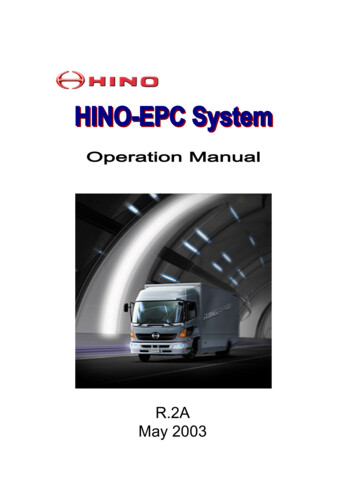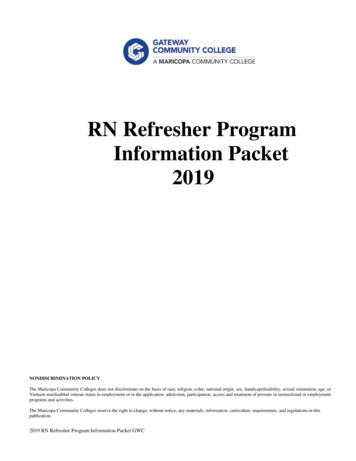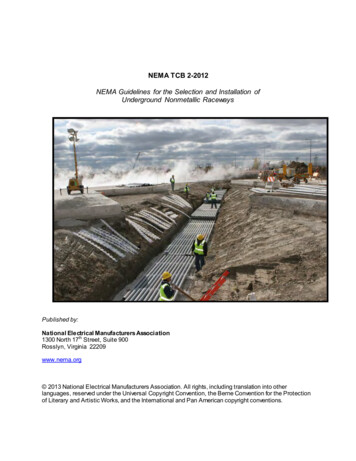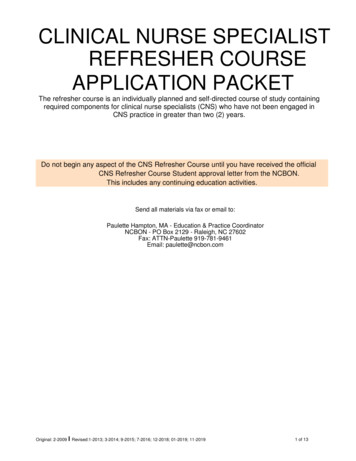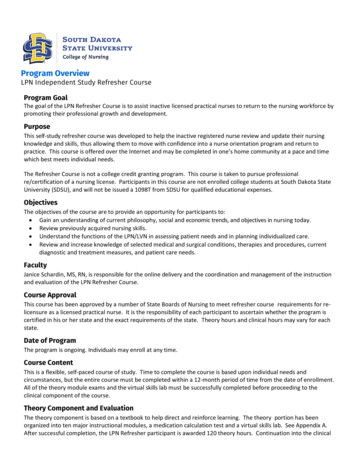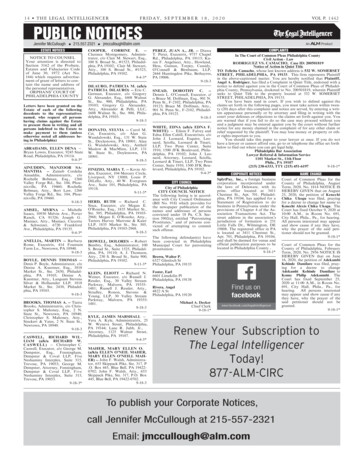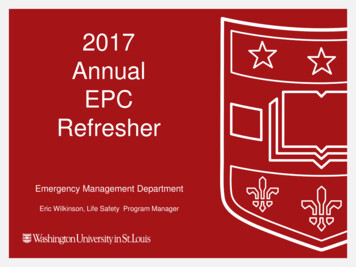
Transcription
2017AnnualEPCRefresherEmergency Management DepartmentEric Wilkinson, Life Safety Program Manager
Objectives Program Updates Review Emergency Procedures Campus Safety Presentation Scenario-based Discussion
Roles & Responsibilities Liaison – Point-of-contact between yourdepartment and Emergency Management. Prepare – Provide periodic updates to yourpersonnel on basic life safety information andemergency procedures. Respond – Support implementation of emergencyprocedures when necessary.
Update Contact InformationWithin “Employee Self Service” in HRMS,employees can review their contactinformation and certify its accuracyannually. Updated contact information– allows for the creation of employeelists for accountability during or afteran emergency– can help to make sure you can bereached with our campus notificationsystems.
Objective #1ProgramUpdates
Merged Department
Continuity Planning The goal is to enable thecontinuation of operationsduring, or immediatelyfollowing disruptiveincidents and to quicklyresume essentialfunctions allowing faculty,staff and students tolearn, teach, performresearch and deliverpatient care.
Communications & Marketing Conducting focus groups with students, facultyand staff members to assess communicationsduring emergency and non-emergency situations Rebranding/marketing campaign planned forSeptember 2017, with events taking place on theDanforth and Medical Campuses
EM WebsiteLaunched all new EmergencyManagement website in late2016 More customer-focused One source for program andtraining information, as well aspreparedness tips Includes an “Announcements”section on the home page forup-to-date newswww.emergency.wustl.edu
Training & Exercises Target Audience– Personnel with operational responsibilitiesduring a disaster or emergency event thatimpacts campus Goal– Coordination
Preparedness TrainingTraining CoursesEMGT 2001 – Initial EPCTrainingEMGT 2003 – FireSafety & ExtinguisherEMGT 2005 – ActiveShooter ResponseCPR/AED – Monthlythrough FPP/EST
Learn @ Work
BARA Project Best Available Refuge AreaUses FEMA standardsStructural EngineersUpdate Emergency Evacuation Maps
Public Safety Center Mid Campus Center(MCC) BJH & WUSM One Combined DispatchCenter One Emergency PhoneNumber Emergency OperationsCenter
Notable Events Statewide Tornado Drill National PreparednessMonth Great AmericanShakeout
Objective #2ReviewEmergencyPreparednessProcedures
Be Ready!Key Points:Be AwareBe PreparedBe InformedTake Action
Situational AwarenessBeing aware of one'ssurroundings andidentifying potentialthreats and dangeroussituations
Top WU HazardsTornadoUtility FailureFireEarthquakeSevere ThunderstormHazardous Material SpillSevere Blizzard/Snow FallMass CasualtyBuilding FloodPandemic FluTemperature ExtremeActive Shooter/Civil DisturbanceWorkplace Violence*New Hazard – IT/Cyber Attack*
Cooper’s Color Code
Severe Weather Impending severeweather Local news National weatherservice Know it’s comingbefore it hits Watches vs. Warnings
Suspicious BehaviorTrust your instincts! Establish abaseline of normal Look for anythingoutside thebaseline Take action ifnecessary You have a lifetimeof experience
Current Eventso Current trendsin crimeo Impendingsevere weathero Upcomingeventso Possiblecopycats
Pay Attention! Riding the MetrolinkSitting at a stoplightCrossing the streetEating at a restaurantKeep your head on aswivel, know what’saround you!
Emergency RespondersMedical School, call Protective Services at314-362-4357 (All 10-Digits)Danforth Campus, call WUPD at 314-9355555 (5-5555)North Campus, West Campus, SouthCampus, Tyson Research, 560 Bldg.,Lewis Center, call 911, then call WUPD at314-935-5555BJH/SLCH, call Barnes Public Safety at 314362-0750/0911, then call WUSM ProtectiveServices
Emergency Assembly Points Every building isassigned an EAP If an evacuation isneeded this is where yougo to assemble To find your EAP visit:www.emergency.wustl.edu
Evacuation Maps
Be Prepared?Emergencies can happen Anywhere, Anytime!
Plan Ahead!SEVERE WEATHERREFUGRE AREASEMERGENCYASSEMBLY POINTSECURE ROOMSEVACUATIONROUTE(S)FIRE EXTINGUISHERSPULL STATIONS
Emergency Kitwww.emergency.wustl.edu
Be Informed! WashU Alerts is the University’s Mass Notification Systemfor alerting faculty, staff, students, and campus visitors ofan emergency situation. Phone/voicemessage Text message/e-mail Alertus beacons Desktop pop-ups Fire Alarm System WUSTL APP
Fire FactsFire is FASTThere is little time!In less than 30 seconds a small flame can get completely out of control and turn into a major fire. It only takesminutes for thick black smoke to fill a house. In minutes, a house can be engulfed in flamesFire is DARKFire isn't bright, it's pitch black.Fire starts bright, but quickly produces black smoke and complete darkness. If you wake up to a fire you may beblinded, disoriented and unable to find your way around the home you've lived in for years.Fire is HOTHeat is more threatening than flames.A fire's heat alone can kill. Room temperatures in a fire can be 100 degrees at floor level and rise to 600 degreesat eye level. Inhaling this super-hot air will scorch your lungs.Fire is DEADLYSmoke and toxic gases kill more people than flames.Fire uses up the oxygen you need and produces smoke and poisonous gases that kill.
Fire HazardsBe aware of your surroundings and potentialhazards.Blocked ExitsBlockedEvacuation RouteOverloaded Outlets
Fire SafetyBe Prepared: FIRE EXITS EVACUATION ROUTE(S) FIRE EXTINGUISHERS PULL STATIONS FIRE DRILLS
Building Fire Alarm SystemsBe Informed:Combination of: Visual Strobes, AND Audible Sirens, OR Voice-over SpeakersHigh-Rise: At least 7 floors Floor above/floor below alarms Only evacuate if alarm on yourfloor is soundingLow-Rise: Typically 6 floors or less Alarm sounds through wholebuilding.
Business OccupancyTake Action:Immediately EVACUATE the buildingManually ACTIVATE the fire alarm (pull station) as youevacuateProceed to your designated EMERGENCY ASSEMBLYPOINT (EAP)CALL the Emergency Responders for your locationGET OUT, STAY OUT!
EPC Actions Grab your Red Bag Gather everyone at the EAP Account for employees at EAP Inform responders of anyone still inside
Fire SafetyRemember: R.A.C.E.RESCUE anyone in immediatedangerACTIVATE the ALARMCONTAIN the fire (close doors)EVACUATE the building (DO NOTuse elevators)GET OUT, STAY OUT!
Outpatient ClinicsCAM, CSCC, etc Step One: Stay Put- Reassure PatientsStep Two: Horizontal Evacuation- If evidence of fire condition- Move beyond fire barrierStep Three: Vertical Evacuation- Use Stairwells- Assist patients- Go to the EmergencyAssembly Point
Inpatient HospitalsBJH & SLCHStep One: Defend In PlaceStep Two: Horizontal EvacuationStep Three: Vertical EvacuationStep Four: Building- Only if ordered by PublicSafety officials or the FireDepartment
Small Fires Retrieve the nearest FIREEXTINGUISHER and attempt toput our the fire (RememberP.A.S.S.) If the fire isn’t out in 30 seconds,EVACUATE Immediately! Manually ACTIVATE the firealarm (pull station) CALL the EmergencyResponders for your location
Fire ExtinguishersRemember: P.A.S.S Pull the pin Aim the extinguisher at the baseof the flame Squeeze the trigger Sweep from side to side at the base or source of thefire, and approach the fire slowly, keeping an exitbehind your back
Active Shooter: What is It?The Department of Homeland Securitydefines an Active Shooter as: “An individual actively engaged inkilling, or attempting to kill, peoplein a confined space or otherpopulated area” Typically use a gun No pattern or method to victimselection Unpredictable and evolve quickly
Workplace ViolenceBe Aware: In incidents in which the duration could be ascertained,70% ended in five minutes or less. At least 66.9% of incidents ended before police arrivedand could engage the shooter. In 21 incidents (13.1%), unarmed citizens safely andsuccessfully restrained the shooter.Preparation and mindset are the keys to survival!
Workplace ViolenceBe Prepared:Training and preparation can increasechances of survival: Know your Environment (where torun, where to hide, how to fight) Adopt a Survival Mindset (I will doanything to get home to my family) Know that it can happen Anywhere,Anytime
What To ExpectBe Informed:If a credible threat is received, a WashUAlert may be transmitted:“A person with a weapon has been reportedon the XYZ Campus. Go to a place whereyou feel safe and remain there until furthernotice. For additional updates go toemergency.wustl.edu.”46
Workplace ViolenceTake Action:If someone has started shooting a firearm (ordisplaying a weapon), or is threatening toshoot: RUN/HIDE/FIGHT/REPORT RUN: Exit the building immediately.Notify anyone you see to exit immediately HIDE: If it is not possible to exit, find asafe and secure place such as locking orbarricading yourself in an office or room FIGHT: If your life is threatened by theshooter, fight for your life REPORT: Call the emergency number foryour area and give the dispatcher as manydetails as possible
Consider Your Options
How will you respond?If the threat is located on your campus, initiateRUN, HIDE, FIGHT, REPORT activities. Do you hear gun shots? Do you know the location of theshooter? What information do you have?If the threat is on another campus, do not gothere!49
Workplace ViolenceActive Shooter: After it Happens Remain in a safe location until the situation is over and thescene is safe Provide law enforcement with any information they require Active Shooter situations are traumatic events Get help if you need it Employee Assistance Program (EAP)
Plan AheadWhere can I run? Identify all evacuation routes fromareas in your daily routine.Where can I hide? Identify areas around you where youcan be safer from an active shooter.What if I have to fight? Think of ways to protect yourselfif an active shooter was in your area.Develop a Survival Mindset. I can do this! I will go hometo my family!Stay alert, stay alive!51
Workplace ViolenceEPC ActionsEncourage employees to take training and visit EM Website.Discuss options with coworkers - Have a Plan!RUN, HIDE, FIGHT as the situation dictates.http://emergency.wustl.edu
EarthquakesEarthquakes Happen Almost Every DayMost of them are only detected by seismic equipment
EarthquakesBe Aware: 1811/1812 Quakes:The sequence of quakes that occurred near New Madridincluded three of the most intense ever to occur on thiscontinent. Church bells rang on the east coast.The probability of a repeat of the 1811-1812 earthquakesis 7 – 10%.NMSZ is most active earthquake region in US east of theRockies.Earthquakes in this region would damage an area 20times larger than earthquakes in California.
EarthquakesBe Prepared: Secure heavy objects Move heavy items to lower shelves of floor whenpossible Have a communications plan.– Landlines and cell phone systems may beoverwhelmed– Consider texting or using social media
EarthquakesBe Informed:When theshaking starts,take action!
EarthquakesTake Action: Drop to the floor– Before the earthquake drops you! Take Cover– Under a sturdy desk or table– Get down next to a wall and coveryour head with your arms Hold On firmly– Be ready to move with it until theshaking stops
EarthquakesAfter an Earthquake: Expect aftershocks taking cover eachtime Check for injuries if it is safe to do so Tune in radio, TV or go tohttp://emergency.wustl.edu to get newsand instructions If the building is not safe go to theemergency assembly point and awaitinstructions
Severe WeatherKnow the Terms:Special WeatherStatement / AdvisoryAny type of ther WatchWeather WarningConditions arefavorable for thedevelopment of severeweather in thedesignated area(tornado, severethunderstorm, flashflood, winter storm,etc.)Severe weather isconfirmed andimminent and maypose an immediatethreat to life safety orcause propertydamage.What actions might you take with each of theseproducts?
Severe WeatherBe Aware:What to look for: Dark, often greenish sky Large hail A large, dark, low-lyingcloud (particularly ifrotating) Loud roar, similar to afreight train
Severe WeatherBe Aware: Peak tornado season in the southern states is March –May; in the northern states, it’s late spring throughsummer. Tornadoes typically occur between 3 pm and 9 pm, butcould occur at any time. Tornadoes cause an average of 70 fatalities and 1,500injuries in US Tornadoes usually move travel from southwest tonortheast Tornadoes may appear transparent until dust and debrisare picked up
Severe WeatherBe Aware: Missouri accounts for six of the 25 deadliesttornadoes in US history:– Joplin: May 22, 2011– St. Louis: Sept. 29, 1927– Poplar Bluff: May 9, 1927– Tri-State Tornado: March 18, 1925– St. Louis: May 27, 1896– Marshfield – April 18, 1880
Severe WeatherBe Prepared: Locate the safest Area of Refuge Keep at least one flashlight with extra batteries on hand Keep a battery operated radio on each floor to use only inan emergency
Severe WeatherBe Informed: Outdoor warning sirens (if you are outside) NOAA weather alert radios Cell phone carriers Local TV news/radio WashU Alerts
Severe WeatherTake Action: Evacuate to the lowest level possible, interior space with aflashlight and radio. Use technology to see if it will impact your work area. Use arms to protect head and neck (DUCK and COVER).
Severe WeatherFollowing a tornado on campus: If safe, help anyone injured ortrapped Turn on a radio, TV or get thelatest emergency information@http://emergency.wustl.edu Make emergency calls only(Text if phone lines are down) If the building is not safe, go toyour emergency assemblypoint to receive instructions
Objective #3CampusSafety
PersonalSecurity Inside Buildings:Sound Preparation Let someone know you are working late—family, coworkers, manager. Advise Protective Services that you will beworking late. Park smart. Meters are free after 7:00 p.m.Garages are free after 2:00 p.m. There is safety in numbers. Try to schedulelate nights when others will be present. Lock your office/suite door after hours. Report suspicious persons.
Personal Safety Outside Buildings:Situational Awareness Eyes up! Do not text/email and walk. Beaware of your environment around you. Hang up! Do not walk and talk on yourmobile phone. Volume down! Do not use earbuds. Be particularly careful at crosswalks. Driversdo not always understand their duty to stop.Make eye contact with drivers! Use “the link” when possible.
PersonalSecurity Outside Buildings:Situational Awareness Eyes up, hang up, volume down!Trust your instincts.Use “the link.”There is safety in numbers—walk with others.Take advantage of Protective Services’ safety escorts.Avoid dark areas where someone could hide—walk and parkin well-lit areas.Walk confidently at a steady pace.Keys in hand.Check your vehicle’s back seat prior to getting in.Car trouble? Call Protective Services to assist you or waitwith you for a tow truck.Report suspicious persons!Weapons?
Security While in the Car It’s becoming harder to steal parked cars socrooks often steal cars that are occupied. Plan your route. Avoid trouble spots and areasunfamiliar to you. Keep doors locked at all times and windows up. You are most vulnerable while parked or stoppedat an intersection. Be mindful of the area aroundyou. Do not sit in a parked car. At intersections,leave room in front of the car to make an escape. If you are approached, give the thieves what theywant.
Secure Your Belongings at Work Be on the lookout for “office creepers.” Primary targets for theft are small electronics,laptop computers, and women’s purses. Lock your work area when leaving, even if onlyfor minutes. If you cannot lock your work area door, lockyour valuables in a drawer or cabinet. If you do not have secure storage options,discuss with your manager. Report suspicious persons!
Avoid Vehicle Break-Ins Vehicle break-ins are difficult to police, simple toavoid. Never leave valuables or packages unattended inyour vehicle, particularly afterhours. Secure valuables in your trunk prior to arriving atwork. If driving an SUV, secure valuables in the rearcompartment under a cargo cover. Bring packages inside with you. Leave nothing totemp crooks. It is not just the theft but the damage to your car!
The Takeaway Be aware of your surroundings at all timesfor reasons of both safety and security. Proper preparation and planning will helpyou avoid becoming a victim of a crime. Protective Services is on duty 24/7/365.When in doubt, task us! Reportsuspicious persons, request assistance,request escorts.
Important Contact Info WUSM Campus:Protective du/security/Protective Services Facebook page Danforth Campus:Washington University Police es/Home.aspx Off Campus:St. Louis Metropolitan Police Department911 Emergency314-231-1212 Non-emergency
Objective #4ScenarioDiscussions
Scenario #1What if: You are in a meeting receive an alert that there is aperson with a weapon on your campus. You don’t know thelocation or exact nature of the threat and aren’t very familiarwith where to go or what to do in this location.What do you do? Stay put and eat your lunch until further information isavailable. Wait for others to respond and do what they do. Immediately begin looking for a safe place to hide whilemaintaining a general awareness of your surroundings,looking for signs of a threat in your area. Go to your vehicle, leave campus, and take the rest of theday off.
Scenario #2What if: The fire alarm activates and you and youremployees evacuate the building and meet at your EAP.After taking accountability you realize you are missing anemployee and you’re sure they were in the office minutesbefore the alarm.What do you do? Assume they evacuated safely and do nothing. Inform emergency responders that one of your employeesis missing and you’re unsure of their whereabouts. Go back into the building to find the employee. They mayhave been in the bathroom and didn’t hear the alarm. Buy lunch for the rest of your employees who got outsafely. You didn’t like that employee anyway.
Scenario #3What if: You’re on the twelfth floor of your office buildingand you receive a tornado warning. There’s not time to getto the lowest level of your building via the stairs.What do you do? Go to the window to look at the pretty sky. Go to the nearest enclosed stairwell or interior room andtake cover. Call home to tell your family what is happening. Take the elevator to the lower level since it’s faster.
Scenario #4What if: You’re coming back from lunch and are in thestairwell of your building. The building starts violentlyshaking. You realize it must be an earthquake.What do you do? Try to run back down the stairs and get outside. Run up the stairs to your floor, go to your desk and takecover. Drop your food, get down where you are, and hold on tothe railing in the stairs. See how long you can stay on your feet before theearthquake knocks you down.
Key Safety Tips Have comfortable shoes nearby Have an exit strategy Know your work space/building Plan for those who may have trouble responding Plan for the worst case scenario (smoke, trapped,chaos) Take Action, don’t hesitate!
Action ItemsCreate an accountability listBuy an emergency kitAssess your work areaEducate your coworkersregularlyMake a plan!Attend trainingParticipate in drillsUpdate contact information inHRMS
AccountabilityCreate an accountability list for those that you areresponsible for as an EPC If you are designated in HRMS as an EPC you shouldhave access to download the list
Are you Prepared?
Key PointsBe Aware!Be Prepared!Be Informed!Take Action!
Questions?
ContactInformationEric Wilkinsonwilkinsone@wustl.eduWashU EM: 314-362-6348
Within "Employee Self Service" in HRMS, employees can review their contact information and certify its accuracy annually. Updated contact information . 362-0750/0911, then call WUSM Protective Services Emergency Responders. Emergency Assembly Points Every building is assigned an EAP If an evacuation is needed this is where you
